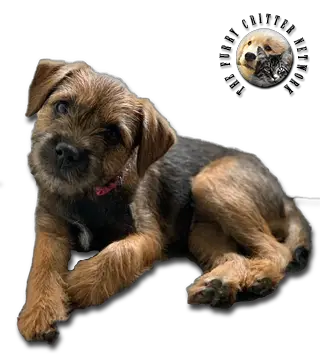Breed Standard
Head: Similar to that of an otter. Moderately broad skull. Strong, short muzzle.
Ears: Small, v-shaped, hanging forward along the cheeks.
Eyes: Dark color.
Body: Tall, narrow, fairly long. Neck of moderate length. Deep ribs carried well back; b loin.
Tail: Moderately short. Fairly thick at the root and tapering toward the tip. Carried gaily but not over the back.
Hair: Hard, dense. Thick undercoat.
Coat: Red, wheaten, grizzle and tan, blue and tan.
Size: Dog : no more than 40 cm (16 in).Bitch : no more than 36 cm (14 in).
Weight: Dog : 5,9 to 7,1 kg (13-16 lb).Bitch : 5,1 to 6,4 kg (11-14 lb).
History
As its name suggests, the Border Terrier originated in the Border country in southern Scotland. The breed is thought to be descended from an ancient type of Bedlington crossed with the Lakeland Terrier and the Dandie Dinmont Terrier. The breed received the name Border Terrier in 1880 and a Border Terrier club was formed in 1920. The breed was initially used to hunt fox and accompany hound packs.
The Border Terrier was bred to have long enough legs to keep up with the horses and other foxhounds, which travelled with them, and small enough bodies to crawl in the burrows of foxes and chase them out so the hunters had a blank shot. The foxhounds that travelled with them were not small enough to do the Border Terrier's job.
Behavior
This rustic, courageous, strong, lively, dog possesses a seemingly boundless supply of energy. In fact, he is capable of keeping pace with a horse. While the border Terrier has a strong personality, he also has a happy disposition. He forms a strong bond with his owners and adores children. This breed is often aggressive when first meeting other dogs. Firm training is required. Due to the emotional sensitivity and loving temperament of the dog, much love and care are necessary. When domesticated, the dog thrives on love and affection. This dog can likely die if neglected for too long.
The Border Terrier can adapt to living indoors if he frequently gets out for long walks. Occasional brushing is all that is required to maintain the coat. Professional grooming is not required.
Function
Working, Field Game, Field Sporting, Pet.
Health
Borders are a generally hardy breed, though there are certain genetic health problems associated with them, including:
Hip dysplasia
Perthes disease
Various heart defects
Juvenile cataracts
Progressive retinal atrophy
Seizures
Canine epileptoid cramping syndrome (CECS)






